Meeting of the Risk
and Audit Committee
Date: 1 May 2024
Time: 9.00am
|
Venue:
|
Council
Chamber
Hawke's
Bay Regional Council
159
Dalton Street
NAPIER
|
Agenda
Item Title Page
1. Welcome/Karakia/Notices/Apologies
2. Conflict
of Interest Declarations
3. Confirmation of Minutes of
the Risk and Audit Committee meeting held on 15 February 2024
Decision
Items
4. Risk
Management update 3
5. Treasury
Compliance Report for the period 1 January - 31 March 2024 9
6. Health,
Safety and Wellbeing update 15
7. Enterprise
Assurance update 31
Decision
Items (Public Excluded)
8. Incident
report - Payroll Holidays Act compliance 45
9. Strategic
risk deep dives 47
Hawke’s Bay Regional
Council
Risk
and Audit Committee
1 May 2024
Subject: Risk Management update
Reason for Report
1. This item and the
accompanying enterprise risk report provide the Risk and Audit Committee (RAC)
with a quarterly update of Council’s risk profile, risk activities and surrounding
environment for discussion and awareness.
Executive
Summary
2. HBRC continues to develop
and work on enhancing risk management and systems in place. With the departure
of the Risk Manager, HBRC has engaged the services of David Nalder, an experienced
Risk Consultant with a background in local and central government. The
primary objective of this work has been to:
2.1. Increase the quality,
relevance, and awareness of HBRC’s risk profile and risk management
process at governance, executive and management levels
2.2. More directly link risk to
decision making, with explicit linkages between HBRC’s purpose and
commitments, major areas of uncertainty presenting both upside opportunity and
down-side threat, and controls/activities that manage these areas of
uncertainty/risk
2.3. Provide a simple and
transparent method of describing key areas of risk, consequences related to
this, critical controls, assurance, and related monitoring mechanism.
3. A review has
been undertaken to validate the strategic risk profile of HBRC by looking at
areas of risk identified by other organisations. Specific sources of information
were: the Office of the Auditor General’s
report into risk within local government; Department
of Prime Minister and Cabinet’s New Zealand national risk register;
LGNZ’s key risks/issues for local government;
and other material such as white papers and thought
leadership from external professional services consultancies, including PwC,
KPMG, EY, Deloitte, AON, Grant Thornton and others across NZ, Australia and the
UK. Pleasingly, common risk themes
identified were all reflected within the Enterprise Dashboard (strategic risk
profile) or supporting one-page management plans (risk assessments).
4. The delivery of the North
Island Weather Events (NIWE) programme (Infrastructure PMO) is critical to the
ongoing success of HBRC and this risk/uncertainty has been added to the
overarching risk profile for HBRC as a new risk (refer to Risk 22 - Rated
moderate). There is significant political pressure being applied to execution
timeframes for delivery. Ensuring there is a balance between political
pressure, winter weather for construction and community engagement will be
crucial to the success of the programme and for mitigating both reputational and
financial risks associated with non-delivery.
5. HBRC was the subject of a
procurement probity check in March 2024 for the Silt and Debris
taskforce. There were no material issues noted in processes supporting
the procurement of contractors for the further $40m funding received in
February 2024.
6. An incident report
pertaining to Holiday Payments has been escalated through to RAC this quarter
and will be considered in public excluded.
7. During March 2024, Hawke’s Bay Civil
Defence Emergency Management Group’s response to Cyclone Gabrielle (the
Mike Bush review) was released. The CDEM Group Joint Committee has formally agreed that
an independent role will be established to lead the remediation of the report’s
recommendations. It is expected that RAC will be provided with the plan and
timeline for actions on the recommendations for oversight and awareness only,
and that the Joint Committee will be accountable for approving and monitoring
the implementation of the work programme for the transformational change required.
Discussion
Risk Environment and Sentiment Surveys
8. The one-page Enterprise
Dashboard represents the strategic risk profile. This is intended to be a
live document with updates to reflect the changing priorities and risks for the
organisation. Since the last RAC meeting, this dashboard has been updated
to reflect feedback at that meeting and the transition from cyclone recovery to
the wider focus on future resilience to extreme weather events. Engagement has
been positive across the organisation.
9. Key insights on the
dashboard this quarter are:
9.1. The removal of the risk
around Impacts of cyclone and recovery. This risk was a point in time
and reflected the uncertainty at the time of creation of cyclone-related
matters such as categorisation, remediation funding, and insurance claim
activities. With the closure of Recovery as a separate matter at ELT,
this risk has now been replaced with the Effectiveness of the NIWE
Resilience programme, and a more general Effectiveness of Emergency
Management.
9.2. The small deterioration
(from low to moderate) for Effectiveness of governance and partnerships,
Our impact on the environment and Effectiveness of infrastructure
asset management. In part, Council officers believe this is due to
staff awareness and further consideration of risks since the creation of the
dashboard and supporting one-page management plans. In one respect this
is positive as it indicates greater clarity and transparency in defining risk
and how this is managed and causes officers to reconsider the extent to which
there are opportunities to increase rigour around how these areas are managed.
9.3. Effectiveness of Technology continues to be of shared
concern from ELT and councillors. With the recent appointment of a new Chief
Information Officer, renewed attention is being applied to getting the critical
controls and infrastructure in place. We expect, over time, this will improve
along with considered control improvements across our network and
infrastructure. Positive strides have been achieved with the
implementation of Techone in particular within the finance team.
9.4. All ELT members and ten
councillors have contributed to the sentiment survey this quarter, the results
of which will be considered in Public Excluded with the Risk deep dives.
Overall, there has been a marked increase in the general level of confidence
expressed by councillors since February, although there is a high degree of
divergence of views between individual councillors. Insights from this
include:
9.4.1. A relatively higher level
of concern in the mind of councillors than that of the ELT
9.4.2. A higher degree of
alignment of view exists at an ELT level than at Council
9.4.3. Amongst councillors, there
were very different viewpoints on common areas of risk/uncertainty – in
some cases, the overall level of confidence expressed by individuals in the
overall risk statements (i.e. trust and confidence from the community that HBRC
enables a healthy environment and a resilient and prosperous community) is much
higher that the aggregate of the individual areas of risk that contribute to
this. This suggested that councillors are more confident in HBRC’s
overall performance than the aggregate of the specific aspects that contribute
to this performance.
9.5. The consultation on the
Long Term Plan continues to generate public feedback and in some areas negative
sentiment (similar to all local authorities across NZ) due to the national and regional
planned rate rises. This is putting pressure on delivery teams (Finance
and Governance) and Communication and Engagement teams to ensure our community
has appropriate information. In part, this negative sentiment is reflected in
uncertainties shown across the councillor sentiment survey by amber ratings for
a number of risks, such as those relating to HBRC’s groups of activities
(e.g. Emergency Management and Transport Management), wider community
engagement (effectiveness of communication, consultation and engagement,
coordination and connectedness of activity and decision making across HBRC) and
ultimate outcomes (we keep our community safe / our impact on the environment).
9.6. A number of regulatory
settings are currently being reformed by Government with potential impacts on
Council’s business. These include the reform and replacement of the
Resource Management Act (during this term of Parliament), changes to national
direction (principally the National Policy Statement for Freshwater Management,
the National Poilcy Statement for Highly Productive Land, and the National
Policy Statement for Indigenous Biodiversity), and changes to the consenting
processes via the fast track regime currently before Parliament. Additional
changes are contemplated to the farm planning system. There is uncertainty
about the final shape of reform of which is reflected as a high risk on our
risk profile.
9.7. Officers have prioritised
the Regional Policy Statement as part of Kotahi and have focussed on the vision
and values work related to freshwater. These are no regrets areas of
work. Farm planning work is largely on hold. HBRC continues to work with
the regional sector through Te Uru Kahika to provide advice to Government and,
where appropriate, HBRC will submit to the select committee on proposed
reforms.
10. This quarter, deep dives
into the following specific areas of risk/uncertainty will be provided in
public excluded time.
10.1. Effectiveness of technology
10.2. Impact of external change
and reform
10.3. Effectiveness of the
investment strategy
10.4. Security, integrity and
privacy of information
10.5. Cyber security.
11. A proposed review and deep
dive schedule is attached and will be used to present information to RAC going
forward.
12. This is intended to give
councillors a common understanding of major areas of importance to HBRC
(purpose, success and uncertainties/risks tied to success) together with
transparency on the control environment underpinning this. This is
important to enable RAC to deliver on its governance obligation or ensuring
that there is an effective system of risk management and internal control in
place.
Assurance
Activities
Organisational Change and
Prioritisation Report
13. Recently Crowe, our
external assurance provider, released the final draft report for Organisational
Change and Prioritisation. (This was agreed within the Enterprise
Internal Audit Plan for 2022-2023.)
14. The scope of the review
looked at opportunities to strengthen decision-making to ensure organisational
change effectively drives the creation of value while ensuring the organisation
is protected from undue risk, e.g., impact on people, compliance, etc, which is
sometimes referred to as ‘risk in change’. (The audit did not
cover the strategic decision-making process on each individual organisational
change initiative and project management process as that was out of scope.)
15. While there was one high
priority finding observed (being that staff members interviewed had differing
interpretations of what a change initiative is), it is pleasing that the
auditors noted that the organisation has the correct tools to enable good
project management going forward. The main themes of the findings for
corrective action and improvement, include:
15.1. A lack of clear definitions
relating to change initiatives
15.2. A lack of formal policies
relating to change and project management
15.3. Development of a change
management methodology
15.4. Project management
requirements
15.5. Prioritisation of
activities.
16. Management will address
recommendations made with the owner being Group Manager Corporate Services.
Hawke’s Bay Civil Defence
Emergency Management Group’s response to Cyclone Gabrielle– Mike Bush
17. This review report was
finalised and released in March 2024, with the purpose of the independent
review being to assess the operational performance of the Hawke’s Bay
Civil Defence Emergency Management Group’s immediate response to Cyclone
Gabrielle, with a particular emphasis on the systems and processes, and roles
and responsibilities of Group members and partners.
18. The formal report has now
been received. A sub-working group of the Coordinating Executive Group (CEG)
has been formed and will provide recommendations on the short-term
recommendations and actions to be undertake to the CEG initially, to then be
presented to the Joint Committee along with a recommendation on an appropriate
structure to successfully implement the review outcomes for the future.
The intention is that this will be presented at the Joint Committee’s
July meeting, if not earlier.
19. Further recommendations are
expected to be relevant to Hawke’s Bay Civil Defence Emergency Management
from the Report of the Government Inquiry into the Response to the North
Island Severe Weather Events. At the time of writing of this paper there
was no indication of how this report will impact other recommendations and what
remediation will be required.
Ernst and Young – Half Year
Financial Statement Review
20. Ernst and Young, our
external auditors are currently onsite performing mid-year controls review as
part of the half year Financial Statement audit. This review involved updating
understanding of processes and controls as well as testing transactional
information for 8 months of the year for certain accounts. No issues have been
identified to date.
21. Last year HBRC received a
qualified audit opinion, primarily based on the decision by HBRC not to
formally value infrastructure assets (due to valuation and impairment work
continuing post cyclone with uncertainty). Formal external valuations
will be completed this year.
Probity Check – Silt and Debris
Taskforce
22. A probity check on the
contracting for the Silt and Debris taskforce was undertaken in March 2024 in
response to concerns raised by the public to government officials pertaining to
potential conflicts or inappropriate controls supporting the programme. In
offering further funding of $40m to the Silt and Debris Taskforce, central
government requested a probity check be undertaken by McHale Group – a
public sector assurance company.
23. While a formal report is
yet to be received, initial email correspondence with McHale Group has
concluded “From a probity perspective and from HBRC’s perspective,
the current tender process is appropriate, justified, and appropriately
approved in relation to supporting the response to the original emergency
situation. The very tight response timeframe (5 ½ working days plus a
weekend) within which companies were required to respond to the tender
invitation was justified within the context of emergency procurement although
with hindsight, improvements could have been made to the process.“
24. This outcome is positive
and further supports other assurance work HBRC has received across the Silt and
Debris programmes, in particular the Agreed-Upon Procedure work
undertaken by PricewaterhouseCoopers in December 2023 specifically looking at
how the Silt and Debris Taskforce operated within the boundaries of eligibility
criteria and the allocation of jobs within the programme. No material issues
were noted in this review.
Decision-making process
25. Staff have assessed the
requirements of the Local Government Act 2002 in relation to this item and have
concluded that:
25.1. The decisions of the
Committee are in accordance with the Terms of Reference and decision-making
delegations adopted by Hawke’s Bay Regional Council 30 August 2023,
specifically the Risk and Audit Committee shall have responsibility and
authority to provide advice and recommend actions,
responses and changes to the Council about risk management, assurance
activities, governance oversight and internal control matters, including
external reporting and audit matters. Specifically this includes:
25.1.1. The robustness of
Council’s risk management systems, policies, practice and assurance
processes. (1.1)
25.1.2. Review whether Council
management has a current and comprehensive risk management framework and
associated procedures for effective identification and management of the
Council’s significant risks in place. (2.1)
25.1.3. Undertake periodic
monitoring of corporate risk assessment, and the internal controls instituted
in response to such risks. (2.2)
25.2. Because this report is for
information only, the decision-making provisions do not apply.
Recommendations
That
the Risk and Audit Committee receives and considers the Risk Management
update staff report.
Authored by:
|
David Nalder
Acting Risk Manager
|
|
Approved by:
|
Susie Young
Group Manager Corporate Services
|
|
Attachment/s
|
1
|
Risk management update 1 May 2024
|
|
Under Separate Cover
|
Hawke’s
Bay Regional Council
Risk
and Audit Committee
1 May 2024
Subject: Treasury Compliance Report
for the period 1 January - 31 March 2024
Reason for report
1. This item provides
compliance monitoring of Hawke’s Bay Regional Council’s (HBRC)
Treasury activity and reports the performance of Council’s investment
portfolio for the quarter ended 31 March 2024.
Overview of the quarter ending 31 March 2024
2. At the end of the quarter
to 31 March 2024, HBRC was compliant with all measures in its Treasury Policy
with the exception of the counterparty risk policy as a result of the
management of recovery funds.
3. During the quarter HBRC
appointed credit rating agency Fitch to provide a public credit rating for
Council and HBRC is expecting an outcome before the end of April. A public
notice will be issued by Fitch on the outcome.
4. The effects of Cyclone
Gabrielle and its recovery continue to impact both cash balances and borrowing
requirements. Additional ongoing borrowing to fund recovery will continue
over the next 3-4 years, while proceeds from insurance claims are slower than
earlier forecast.
Background
5. Council’s Treasury
Policy requires a quarterly Treasury Report to be presented to the Risk and
Audit Committee. The policy states that the Treasury Report is to include:
5.1. Treasury exceptions report
5.2. Policy compliance
5.3. Borrowing limit report
5.4. Funding and liquidity
report
5.5. Debt maturity profile Interest
rate report
5.6. Investment management
report
5.7. Treasury investments
5.8. Cost of funds report, cash
flow and debt forecast report
5.9. Debt and interest rate
strategy and commentary
5.10. Counterparty credit report
5.11. Loan advances.
6. The Investment Management
report has specific requirements outlined in the Treasury Policy. This requires
quarterly reporting on all treasury investments plus annual reporting on all
equities and property investments.
7. In addition to the Treasury
Policy, Council has a Statement of Investment Policy and Objectives (SIPO)
document setting out the parameters required for funds under management for the
HBRC Long Term Investment Fund and the Future Investment Fund.
8. Since 2018, HBRC has
procured treasury advice and services from PricewaterhouseCoopers (PwC) who
provide quarterly Treasury reporting for internal monitoring purposes.
Treasury
exceptions report and policy compliance
9. As at 31 March 2024 all
counterparty exposures were within limits.

10. There were no Investment
Limit breaches in this period relating to funds held by HBRC for its normal
activities.
11. However, during the quarter
to 31 March 2024, there continued to be a number of Investment Limit breaches
relating to cyclone recovery funding received from the Crown and held in the
Jarden and BNZ Recovery accounts. During this quarter total recovery
funds held ranged from ~$32m to ~$78m. HBRC continues to mitigate
potential risks by Jarden managing their funds across both ANZ and Westpac,
meaning funds are split across 3 main registered NZ banks.
12. Council officers maintain
the view that management of Recovery Funding held on behalf sits outside
HBRC’s treasury policy for normal operations, and although reported on,
does not cause a formal breach to limits.
13. This will remain an issue
while HBRC works through the Silt and Debris recovery on behalf of the
Crown. As HBRC moves into the FRP programme with the Crown we expect to
manage cashflow on a monthly basis.
Funding
and Liquidity
14. To ensure HBRC has the
ability to adequately fund its operations, current policy requires us to
maintain a liquid balance of “greater than 10% of existing total
external debt”. Current liquidity ratio is 13.33% and therefore meets policy.
15. The following table reports
the cash and cash equivalents on 31 March 2024.
|
31
March 2024
|
$000
|
|
Cash
on Call
|
3,192
|
|
Short-term
bank deposits
|
―
|
|
Total
Cash & and Deposits
|
3,192
|
16. To manage liquidity risk,
HBRC retains a Standby Facility with BNZ. This
facility provides HBRC with a same-day draw-down option, to any amount between
$0.3-$10.0m, and with a 7-day minimum draw period.
Debt
Management
17. On 31 March 2024 the
current external debt for the Council group was $103m which includes $4.3m of
pre-funded debt ($119.9m including loan from HBRIC).
18. Since Q2 there has been no
additional new borrowing. However, during this quarter we have continued
to push our short-term borrowing out in anticipating of a credit rating,
allowing us to capture lower interest rates.
19. The following summarises
the year-to-date movements in Council’s debt position.
Summary of HBRC Debt
|
|
HBRC only
$000
|
HBRC Group
$000
|
|
Opening Debt – 1 July 2023 – excl HBRIC
Loan
|
84,830
|
84,830
|
|
New Loans raised*
|
84,500
|
84,500
|
|
Less amounts repaid
|
(66,015)
|
(66,015)
|
|
Closing Debt 31 March 2024 (excluding HBRIC
loan)
|
103,315
|
103,315
|
|
Plus opening balance - loan from HBRIC
|
16,663
|
―
|
|
Total Borrowing as at 31 March 2024 *
|
119,978
|
103,315
|
*Includes pre-funding
debt of $4.3m.

20. Council’s debt
maturity profile remained compliant, however short-term drawdowns continue to
put pressure on the policy limit in the 0–3-year bucket. This is
expected to remain high while the credit rating process is underway. We
will then look to transition short-term debt out to longer term, utilising any
insurance proceeds to minimise future funding. The table below includes
our $10m BNZ overdraft in total debt.

Funding
summary
21. HBRC had no new borrowing
in Q3 but rolled over $25m short term borrowing. We anticipate relieving
the pressure on the 0–3-year bucket by converting short-term debt to long
term after the credit rating process is complete.
22. HBRC officers are currently
investigating the options of ‘Green Loans’ with LGFA, as an
alternative to standard bonds. These are available to fund sustainability
projects that promote environmental and social wellbeing, or act on climate
change and reduce greenhouse gas emissions. Projects that fit these
criteria attract lower interest rate charges than standard LGFA bonds.
23. Any insurance or NEMA
proceeds will be used to offset further funding requirements anticipated in the
new financial year.
Borrowing
limits
24. Council continues to
monitor and work within the agreed borrowing limits set by both Council and the
LGFA.

Interest
rate risk
25. Council currently holds
$50m in fixed rate instruments, hedging 46% of current external debt, and
remains compliant to policy. This is based on the draft FY2025-2027 LTP
plan.

Managed
funds
26. Total Investment Fund
portfolios capital at 31 March 2024 is $167m. Adjusted for inflation this is
$0.938m below the inflation-adjusted contribution target. No divestments have
been made from managed funds this year.
27. Based on results to date,
the current fund structures are not sufficient to deliver the returns required
to meet Council’s requirement. This is being addressed by the
updates to the Investment Strategy and the transfer of management of these
assets to HBRIC which is currently undertaking an RFP process for new investment
managers.
28. Council currently budgets
separately for revenue from directly-held managed funds and those held by
HBRIC. HBRIC is required to deliver an overall portfolio return by way of an
annual dividend agreed through an annual Statement of Intent. The composition
between revenues from managed funds and other sources such as Port dividends,
is up to the HBRIC board. While the Council budgeted to receive $10.9m in
dividends from HBRIC within the FY 2023-2024, Council has received only $3.9m
to date due to reduced earnings from the Port. It is anticipated the overall
dividend will fall short of the Council budget for the year.
29. The following table summarises the fund balances at the
end of each period and the graph illustrates the asset allocations within each
fund at 31 March 2024.
|
|
30 Sept 2023
|
31 Dec 2023
|
31 Mar 2024
|
|
Fund Balances HBRC
|
$000
|
$000
|
$000
|
|
Fund Balance HBRC
|
108,038
|
114,407
|
118,752
|
|
Capital Protected Amount HBRC (2% compounded since
inception)
|
117,124
|
117,709
|
118,298
|
|
Current HBRC value above/(below) capital protected amount
|
(9,086)
|
(3,302)
|
(454)
|
|
Funds Balances (Group + HBRIC)
|
|
Long-Term Investment Fund (HBRC)
|
47,164
|
49,975
|
51,844
|
|
Future Investment Fund (HBRC)
|
60,874
|
64,432
|
66,908
|
|
Total HBRC
|
108,038
|
114,407
|
118,752
|
|
Plus HBRIC Managed Funds (FIF)
|
44,415
|
47,138
|
48,810
|
|
Total Group Managed Funds
|
152,453
|
161,545
|
167,563
|
|
Capital Protected Amount (2% compound inflation)
|
166,828
|
167,662
|
168,500
|
|
Current group value above/(below) protected amount
|
(14,375)
|
(6,117)
|
(938)
|

30. Financial markets have
continued to rally this quarter and as at 31 March 2024 the consolidated
portfolio value was up 7.09% on 30 June 2023. Fund performances have also
improved this quarter, although much of this is in unrealised gains and
therefore subject to market volatility. Under current policy all cash returns
reinvested.



Cost
of funds
31. Rolling 12 months to 31 March
2024, Gross Cost of Funds (COF) was 4.15% and Net COF was 3.99%.
HBRIC
Ltd
32. In accordance with Council
Policy, HBRIC provides separate quarterly updates to the Corporate and
Strategic Committee.
Decision-making process
33. Council and its committees
are required to make every decision in accordance with the requirements of the
Local Government Act 2002 (the Act). Staff have assessed the requirements in
relation to this item and have concluded:
33.1. The decisions of the
Committee are in accordance with the Terms of Reference and decision-making
delegations adopted by Hawke’s Bay Regional Council 30 August 2023,
specifically the Risk and Audit Committee shall have responsibility and
authority to:
33.1.1. Review the Council’s revenue and expenditure
policies, amongst others, and the effectiveness of those policies in ensuring
limited risk is generated. (1.3)
33.2. Because this report is for
information only, the decision-making provisions do not apply.
Recommendation
That
the Risk and Audit Committee receives and notes the Treasury Compliance
Report for the period 1 January – 31 March 2024.
Authored by: Approved
by:
|
Tracey O'Shaughnessy
Treasury & Investments
Accountant
|
Susie Young
Group
Manager Corporate Services
|
Attachment/s There are no attachments
for this report.
Hawke’s
Bay Regional Council
Risk
and Audit Committee
1 May 2024
Subject: Health, Safety and Wellbeing
update
Reason for report
1. This item provides the
Audit and Risk Committee with:
1.1. An update on progress
transitioning the Council’s Health, Safety and Wellbeing Management
Framework (HSWMF) to comply with the ISO 45001:2018 Occupational health and safety management
systems requirements,
including the findings of the desktop review.
1.2. An overview of HBRC’s
HSWMF including the roles of governors and Council staff, and H&S incident
reporting.
Executive
Summary
2. The HSW Team Leader
reported to the Risk and Audit Committee in October 2023 on the intended alignment of the HBRC Health, Safety and Wellbeing
Management System (HSWMS) with the ISO45001 framework,
including ongoing assurance over Health and Safety matters. This item provides
a summary of findings of the ECAAS Certification’s Gap Analysis and the report itself is
attached.
3. The purpose of providing an
explanation of the Council’s health, safety and wellbeing system, is to
provide a broad understanding of how the system works.
Background
4. From 2001 to 2019
HBRC’s HSWMS was audited and certified under the ACC Workplace Safety
Management Practice (WSMP) audit standard. The WSMP audit standard aligned with
AS/NZS 4801:2001, the joint Australia/New Zealand Standard for Occupational
Health and Safety Management Systems. While organisations may have sought
certification under AS/NZ4801 or OHSA 18001, this was generally in response to
parent company and/or customer requirements and not common. In terms of market
acceptance within NZ, ACC WSMP was the ‘default’ standard.
5. Despite the impacts of
Covid 19 lockdowns of 2020-2021 and the staffing levels within the HSW team,
HBRC’s HSWMS was maintained at a level commensurate with WSMP Tertiary.
This was verified via an internal review conducted in 2022.
6. In 2022, the HSW Team and
ELT agreed to the need for a new HSW audit programme to replace the defunct ACC
WSMP and investigations to determine which might best suit HBRC.
7. As an initial step in the
investigation, the HSW team sought information from the wider health and safety
community, which included other councils such as Napier City and Horizons
(Manawatu-Whanganui Regional Council), about their progression from ACC WSMP
into other audit programmes. From the discussions held and evidence observed,
the majority had maintained their HSMS (updated as relevant to meet any
applicable legislative or industry changes) but had not progressed into another
certification programme. Organisations who had moved to another certification
programme undertook one of the following options:
|
Programme
|
Programme Status
|
Certification availability
|
|
AS/NZ4801
|
Available superseded until
13 July 2023. After 13/7/23 refer to ISO45001.
|
N/a
|
|
OHSA 18001
|
Withdrawn replaced by
ISO45001
|
N/a
|
|
ISO45001
|
Current
|
Yes
|
|
Safe+
|
Current
|
No* outcome defined by 3 performance levels
|
8. In October 2023 it was
agreed that a review of the current health and safety management systems would
be undertaken with the intention of moving to ISO 45001 Occupational health and
safety management systems requirements as the Council’s new HSW audit programme.
The review was undertaken in November 2023 and the findings and actions to
remediate those are outlined following and contained in attachments 1 and 2.
ISO
45001 Gap analysis
9. The ECAAS Certification’s Gap Analysis occurred
on 28 and 29 November 2023 with the review report being provided to the CE (as
the PCBU) in December 2023 for discussion at the 19 February 2024
Executive Leadership Team meeting.
10. Key findings of
the review, and actions to address them, include:
10.1. Consultation
and Participation – the HSW Committee is well established, however, the Terms
of Reference need to be made more explicit.
10.1.1. After
consultation with the HSW Committee, this is now complete. The HSW Committee
will have further opportunities to consult and participate in the HSWMS, and
for this to be evidenced as per the requirements of the standard.
10.2. Internal Audit
– future internal audits will need to be conducted against ISO45001.
10.2.1. The document
review forms part of the HSW internal audit programme, and will serve to meet
the requirements (in the first instance) as we move forward.
10.3. Legal
requirements – Work Methods need to detail the exact requirements of
10.3.1. HBRC uses Work
Methods (previously called Codes of Practice) to outline the procedure,
inherent risks, and the controls related to a specific task. Each Work Method
(WM) refers to applicable legislation, industry guidelines, standards, Approved
Codes of Practice, etc. Most of the WM do not detail
the exact requirements of these, e.g. will refer to Civil Aviation Rules
but not specify which part of the rules apply. There is no central repository
for this information. The knowledge for the level of detail the standard
requires very likely exists within the HBRC, but it will take some time and
resource to map out.
10.3.2. As the
specifics are mapped, HBRC must also evaluate its compliance with the
requirements. Compliance evaluation outcomes will feed into the requirements
for monitoring, measurement, analysing, evaluation, and
management review.
10.4. Management of
change
10.4.1. The current
change management process will need to be redefined in line with ISO45001
requirements.
10.5. Non-conformances
& continuous improvement
10.5.1. Under ISO45001,
non-conformances are not limited to just incidents (injury, damage, near miss
etc) but also include any instances of not meeting the performance measures of
the HSWMS itself. A process to record HSWMS non-conformances has been included
in the Incident Report Form and will also feed into the requirements for
monitoring, measurement, analysing, evaluation, and management review.
10.6. Objectives
– HBRC needs to establish HSW objectives at relevant functions and
levels (PDP).
10.6.1. Objectives for
the HSW Committee have recently been finalised, and the HSW Team objectives are
included in the 2024 and 2025-2027 work plans.
10.6.2. Objectives for
management or similar will need to be scoped and will be related to things such
as completing investigations of incidents or closing out incidents within a
specified time period.
10.6.3. The first two
objectives are part of the incident management process already, albeit without
the specific measures. Including measures (objectives) will contribute to the
improvement of HBRC’s HSWMS, provide more structure and accountability
for the incident management process, and feed into the criteria HBRC uses to
monitor the performance of the HSWMS.
10.7. Monitoring,
measurement, analysis, evaluation and management review – HBRC
has established safety performance reporting, and a new HSW performance
dashboard is in the process of being developed.
10.7.1. HBRC had
established safety performance reporting; it was also noted that a new HSW
performance dashboard was in the process of being developed. This area
will need further development to ensure that not only is HSW performance being
measured, monitored, evaluated, and updated, but that also the performance of
HBRC’s HSWMS is being measured, monitored, evaluated and updated.
10.7.2. The Management
Review process (of the HSWMS) will need to be updated to capture the above
points and any other specifics required for ISO45001.
11. Being based on
the ACC WSMP standard, it was expected that updates to the HBRC HSWMS would be
required to meet ISO45001 requirements. However, not meeting requirements of a
standard does not mean an organisation is not meeting the intent of relevant
legislation, e.g. The Health and Safety at Work Act 2015.
12. With the HSW
Strategy and Workplan due for renewal, the timing is opportune to update the
HSWMS as part of the new HSW 2024-2027 Strategy and Workplan.
HBRC’s Health, Safety and Wellbeing Management Framework
Overview
13. The HSWM system that HBRC
operates under is a framework to support and maintain a level of employee
safety, health, and wellbeing excellence. It enables the organisation to
identify, manage and reduce risk to create a safe working environment for
everyone under our umbrella – staff, volunteers, contractors and the
wider public. Underpinning this framework is leadership, management, a vast
number of policies, work methods (procedures with risk controls), staff
participation, training, investigations, and assurance.
14. HBRC has a system of
continuous improvement and reviews to ensure that the health, safety, and
wellbeing of all is an evolving process – supported by a work plan that
is reviewed annually and agreed by the Executive Leadership Team (ELT) then signed
off by the Chief Executive (CE).
15. Overarching the HSW work
plan is the Health, Safety and Wellbeing Strategic Plan (HSWSP), which is due
for its 3-yearly update. The 2021-2024 HSWSP will be updated for acceptance by
the ELT and the CE before being presented to Council in July 2024. The
underpinning HSW work plan is currently being updated to incorporate the desk
top review recommendations and updates to general health, safety and wellbeing
objectives for the next 3 years and will be presented to the CE and ELT for
approval.
Role of Council governors and management
16. The
difference between Governance and Management, in the simplest terms, is that governance is responsible for oversight and planning while
management takes care of the daily operations, for example:
16.1. HBRC
governors and ELT sign off the HSW Strategy every 3 years.
16.2. The
HSW Team Lead reports to ELT when required as well as in future, presenting a
monthly HSW dashboard with metrics (under development).
16.3. The
HSW team updates the HBRC Organisational Performance report every 3 months
(OPAL3) which includes incidents, training, and wellbeing which ELT and
governors have access to.
16.4. A
monthly Health
Safety and Wellbeing of people report is part of the Risk and Assurance Maturity work
programme as a live document with the Asset Management Group Manager as the
risk champion. This document is accessed by ELT and presented to the Risk and
Audit Committee by David Nalder (Consultant).
HBRC health and safety incident reporting
17. An incident form (PINC) is
used to record all health, safety or wellbeing incidents and allows for a single process across Council to manage
reportable events. An event can
be an accident, near miss, incident,
complaint, work related injury or illness, or property damage. All events must be notified immediately, or as soon as
reasonably practicable. As soon as the event is lodged in the HSW system,
notifications go to the reporting Group Manager, direct manager and HSW.
18. Incidents are investigated
by the HSW team in conjunction with the worker, the person they report directly
to and their Manager. This includes actions required to minimise the likelihood
of the event (or a similar event) happening again and a review of current controls,
policy or Work Method if the event is linked to a risk/hazard that is already
being managed. If additions or amendments to policies or the Work Method are required,
these will be discussed with all
relevant staff immediately and training will be provided if the risk/hazard
process or controls change. Any
changes are circulated back through the HSW Committee and circulated through
group meetings and internal communications (Snappy and Team Connect).
19. All incident reports are
collated monthly for reporting to the wider business and presented at all group
meetings. Quarterly updates are presented to the Health, Safety and Wellbeing
Committee, the Executive Leadership Team and, through the Organisational
Performance Report, the Corporate and Strategy Committee.




Financial and resource implications
20. The transition to align
with ISO45001 is
an ambitious piece of work, however, at this stage there are no financial or
resource implications to consider.
Next steps
21. Recommendations from the ECAAS
Certification Gap Analysis will be incorporated into the HBRC HSW Work Plan for
2024-2027. This is underway but is an extensive piece of work, alongside the
general HSW objectives in the workplan for the HSW team. This will take more
than 12 months to change, document, socialise, and embed before a further
review of documentation or gap analysis can be considered.
22. The Health, Safety and
Wellbeing Strategy for 2024-2027 will be updated and presented to ELT and RAC
for approval.
23. ECAAS
Certification’s Gap Analysis recommendations will be reported via
the Audit Assurance Dashboard (similar to attachment 2), to update RAC
quarterly on progress.
Decision-making process
24. Council and its committees
are required to make every decision in accordance with the requirements of the
Local Government Act 2002 (the Act). Staff have assessed the requirements in
relation to this item and have concluded:
24.1. The decisions of the
Committee are in accordance with the Terms of Reference and decision-making
delegations adopted by Hawke’s Bay Regional Council 30 August 2023.
The Risk and Audit Committee has responsibility and authority to:
24.1.1. provide advice and
recommend actions, responses and changes to the Council about risk management,
assurance activities, governance oversight and internal control matters,
including external reporting and audit matters. Specifically, this includes:
24.1.1.1. the appropriateness of controls
to safeguard the Council’s financial and non-financial assets, the integrity
of internal and external reporting and accountability arrangements. (1.2)
24.1.1.2. Council’s compliance
with applicable laws, regulations, standards and best practice guidelines. (1.5)
24.1.1.3. receive the internal and
external audit report(s) and review actions to be taken by management on
significant issues and recommendations raised within the report(s). (2.8)
Recommendations
That the Risk and Audit Committee:
1. Receives and considers the Health,
Safety and Well-being update staff report.
2. Confirms that the actions
taken to address the ECAAS Certification Gap Analysis findings are adequate in the
circumstances explained.
Authored by:
|
Kirsty McInnes
Team Leader Health Safety &
Wellbeing
|
|
Approved by:
|
Susie Young
Group Manager Corporate Services
|
|
Attachment/s
|
1
|
ECAAS HSWMS Gap Analysis Nov23
report
|
|
Under Separate Cover
|
|
2⇩
|
ISO45001 Document Review
recommendations
|
|
|
|
3⇩
|
Health and Safey on a Page
|
|
|
|
4⇩
|
Health, safety, resilience and
wellbeing of people - One-page Risk Management Plan
|
|
|
|
ISO45001 Document Review recommendations
|
Attachment
2
|

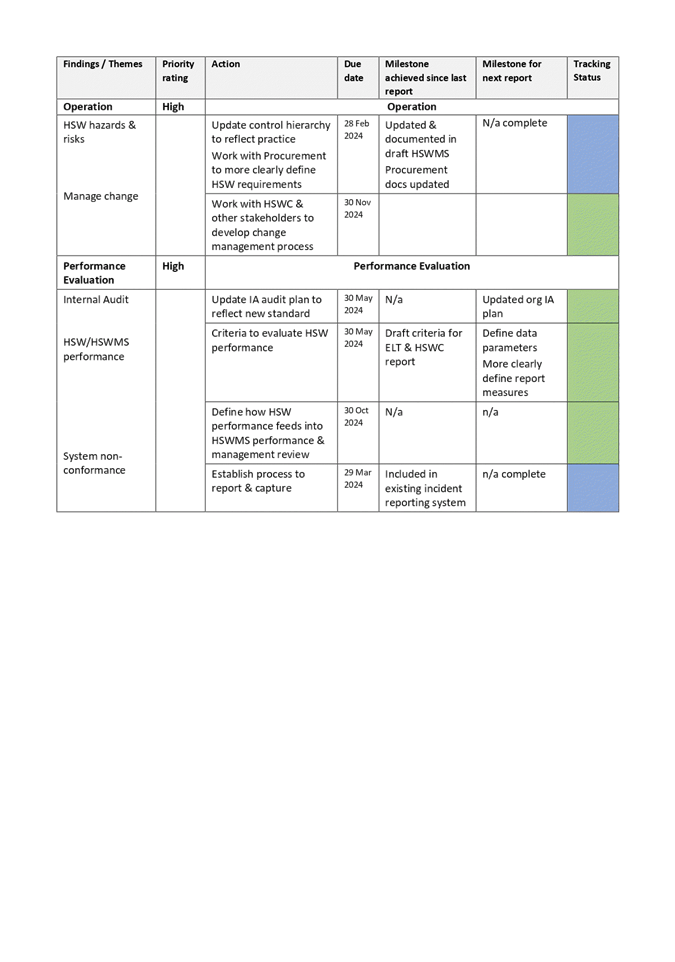
|
Health and Safey on a Page
|
Attachment
3
|
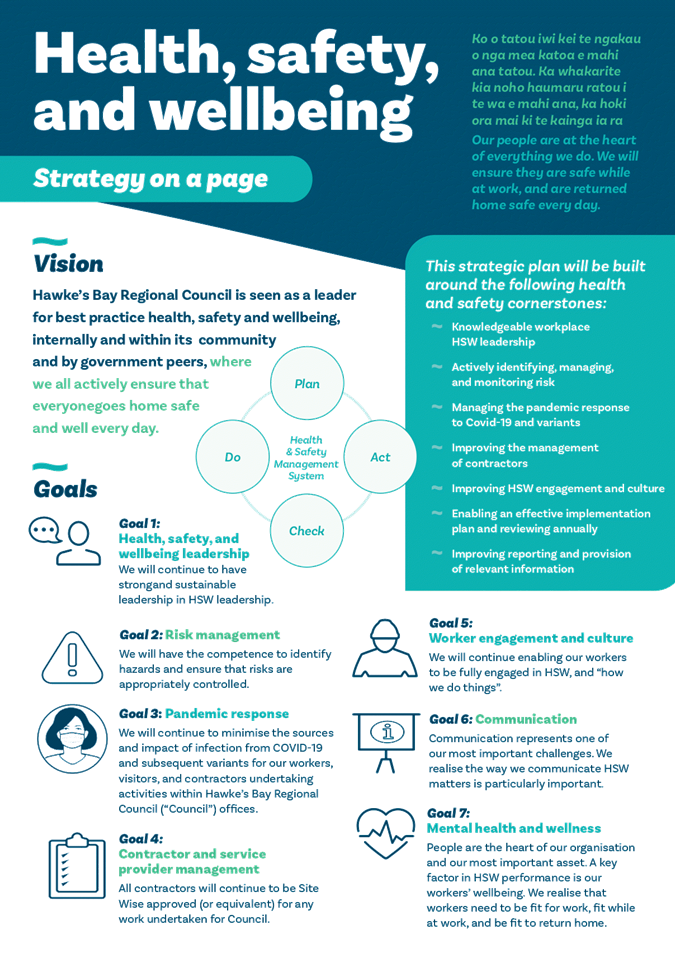
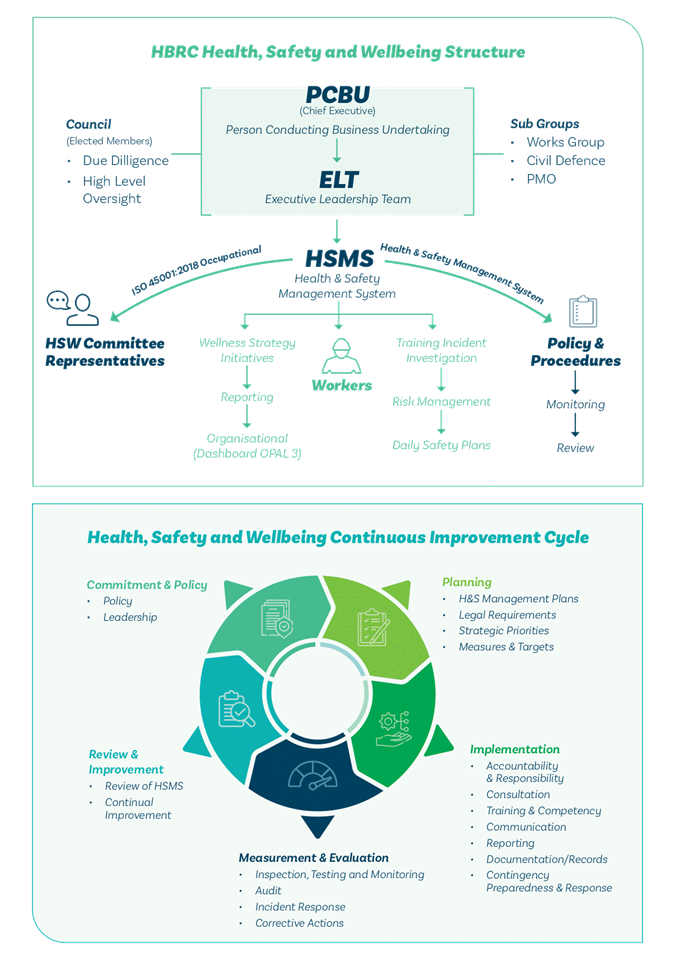
|
Health, safety, resilience and wellbeing of people - One-page
Risk Management Plan
|
Attachment
4
|
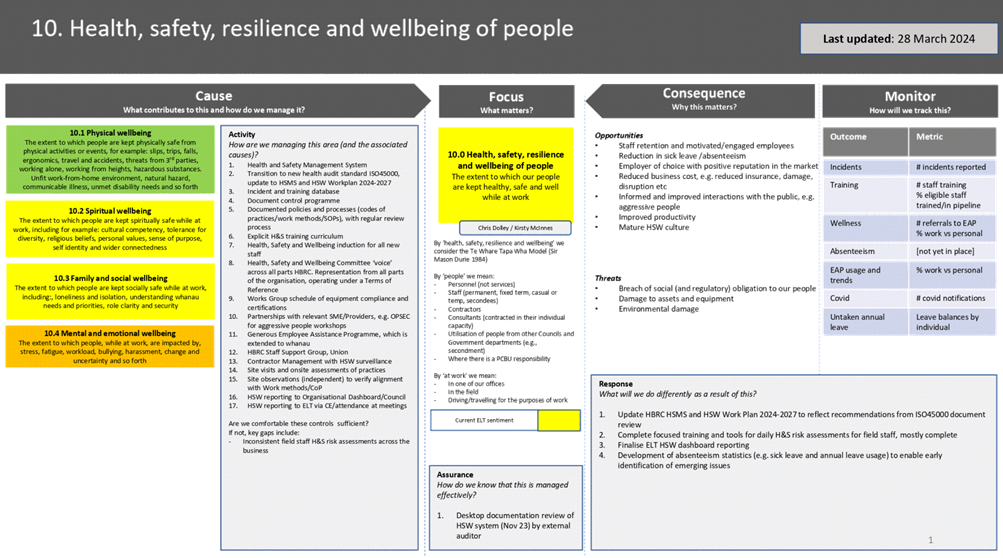
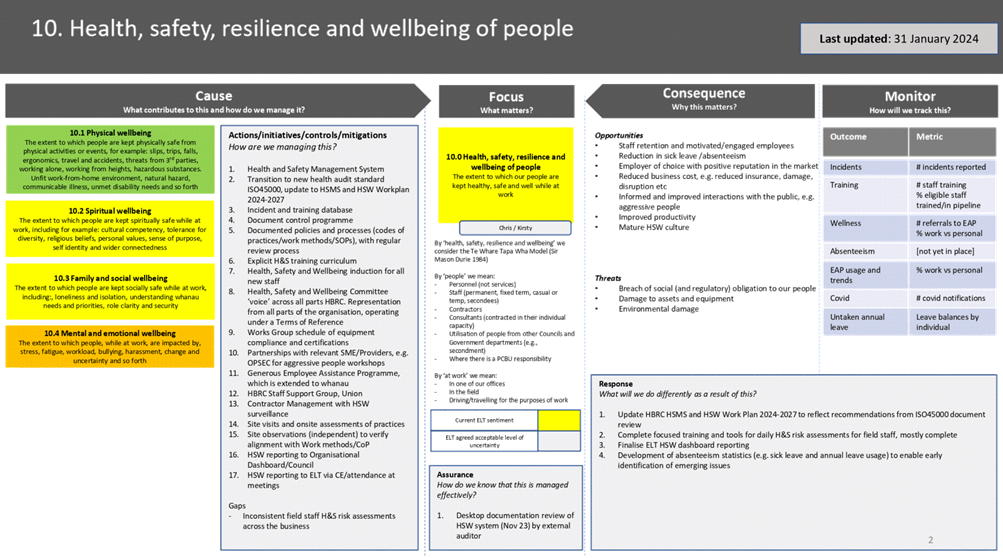
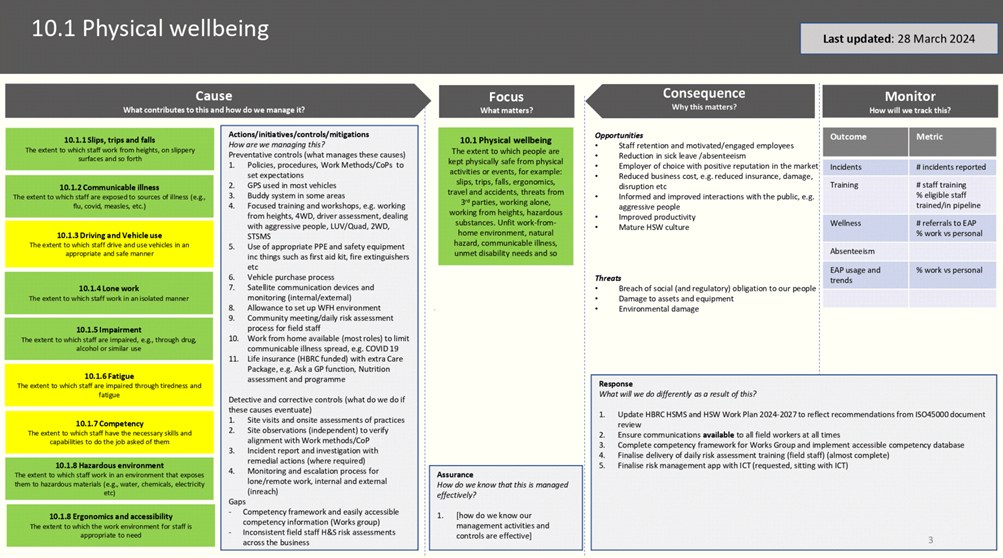
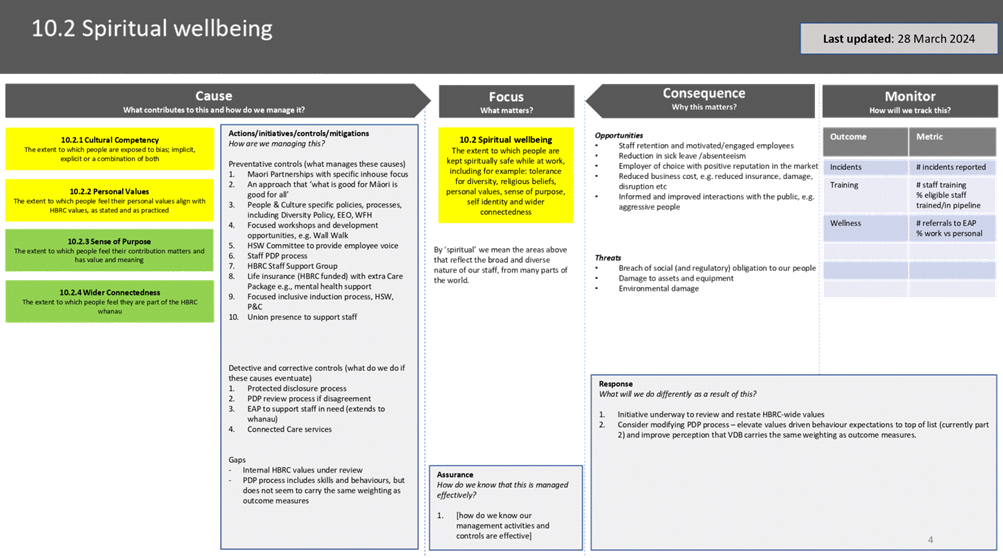
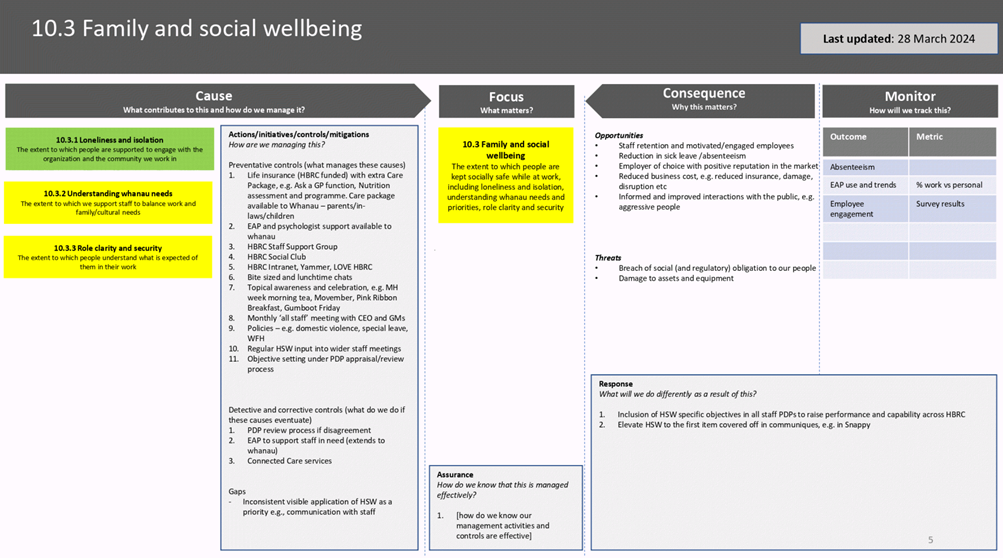

Hawke’s Bay Regional
Council
Risk
and Audit Committee
1 May 2024
Subject: Enterprise Assurance update
Reason for Report
1. This item updates the Risk
and Audit Committee (RAC) on the progress of the following dashboards:
1.1. Internal Assurance
Corrective Actions Dashboard outlines progress of the agreed corrective actions
(with priority risk ratings medium and high) that respond to findings from
enterprise internal assurance reviews that have been previously reported to the
RAC.
1.2. Assurance Universe
Dashboard provides a clear picture of the audits/reviews (including S.17a)
completed and proposed for the future.
1.3. Assurance Plan for FY
2022-23 and 2023-24 gives the position of the reviews for the last and current
financial years.
Discussion
2. The Internal Assurance
Corrective Actions Dashboard is attached.
3. The corrective action
status update provides oversight to the RAC of the progress of actions taken to
address open internal assurance findings, including total issues raised, how
many closed and how many remain open. The table below is a summary of the
open audits/reviews.
|
Audit Performed
|
Review
Type
|
Date
|
Total Issues raised
|
Issues
Closed
|
Issues
Open
|
Comments
|
|
Regional Assets
|
Section 17a
|
March 2020
|
N/A
|
0
|
3
|
Of the remaining three actions, two are ‘on
track’ and one is ‘at risk’.
|
|
Risk Management Maturity
|
Internal Audit
|
June 2020
|
11
|
10
|
1
|
One remaining action is ’behind’.
|
|
HBRC Talent Management Report
|
Internal Audit
|
April 2021
|
8
|
6
|
2
|
Two remaining actions are ‘behind’.
|
4. The dashboard gives
visibility of:
4.1. open findings of the
milestones plus milestones completed and to be completed by the next RAC plus
the tracking status since last reported.
4.2. a summary of closed actions
since the last RAC report.
5. The Assurance Universe
Dashboard is attached. This links
enterprise reviews or audits undertaken over the past five years, the current
year, and future years to an enterprise risk. Reviews and audits in the Assurance
Universe include external audits, enterprise internal audits, business reviews
with an enterprise focus, and section 17a reviews.
6. The Assurance
Plan for FY 2022-23 and 2023-24 is attached. This gives a status of
overflow from 2022-23 approved audits and the current status of FY 2023-24.
Financial and resource implications
7. The budget provided for
internal assurance in 2024-2025 is $64,600.
8. Budget provisions for s.17a
reviews are allocated via the budgets of those activities identified in the
Assurance Universe.
Decision-making process
9. Council and its committees
are required to make every decision in accordance with the requirements of the
Local Government Act 2002 (the Act). Staff have assessed the requirements in
relation to this item and have concluded:
9.1. The decisions of the
Committee are in accordance with the Terms of Reference and decision-making
delegations adopted by Hawke’s Bay Regional Council 30 August 2023,
specifically the Risk and Audit Committee shall have responsibility and
authority to:
9.1.1. Receive the internal and
external audit report(s) and review actions to be taken by management on
significant issues and recommendations raised within the report(s). (2.8)
9.1.2. Ensure that recommendations
in audit management reports are considered and, if appropriate, actioned by
management.
(3.5)
Recommendations
That the Risk and Audit Committee
1. Receives and notes the Enterprise Assurance update staff report.
2. Confirms that the Internal
Assurance Corrective actions update report has provided adequate
information on the status of the Internal Assurance Corrective Actions.
Authored by:
|
Olivia Giraud-Burrell
Quality & Assurance Advisor
|
|
Approved by:
|
Susie Young
Group Manager Corporate Services
|
|
Attachment/s
|
1⇩
|
Internal Assurance Dashboard May
2024
|
|
|
|
2⇩
|
Internal Assurance Plan FY22-23 and
2023-24 May 2024
|
|
|
|
3⇩
|
Assurance Universe
|
|
|
|
Internal Assurance Dashboard May 2024
|
Attachment
1
|
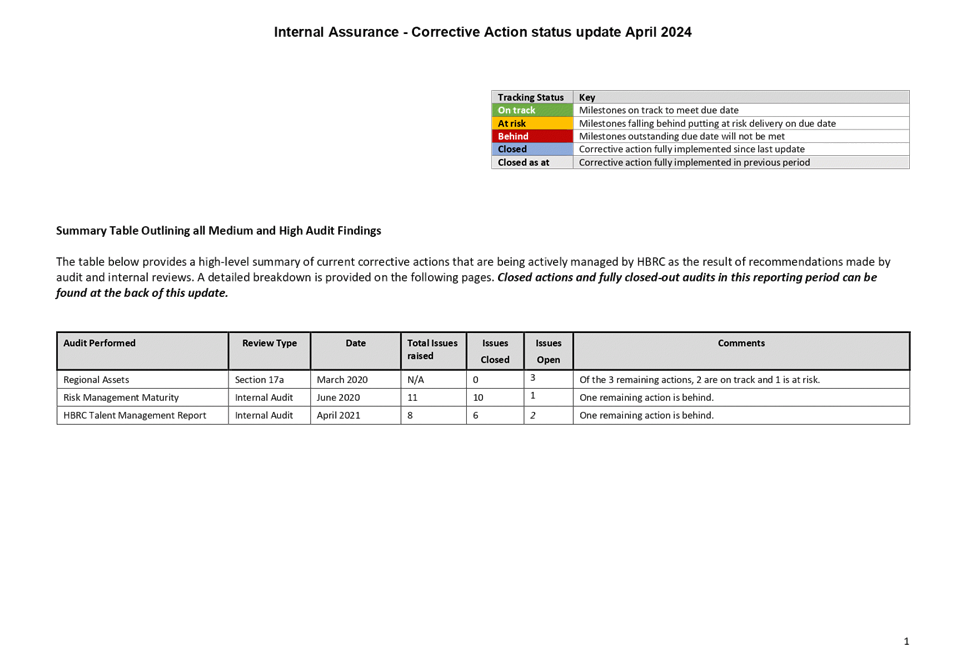
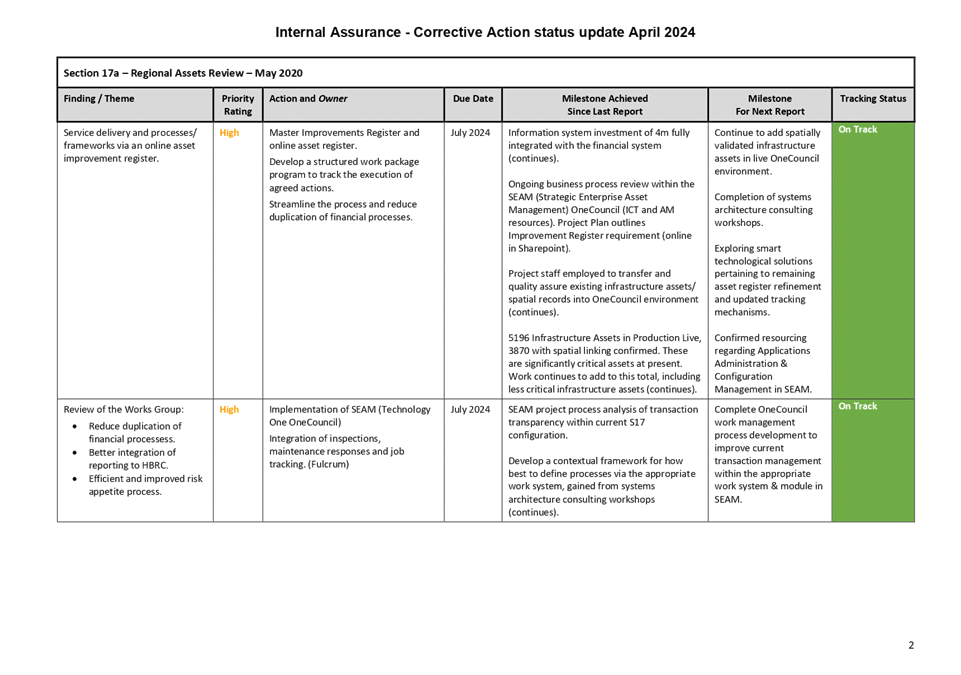
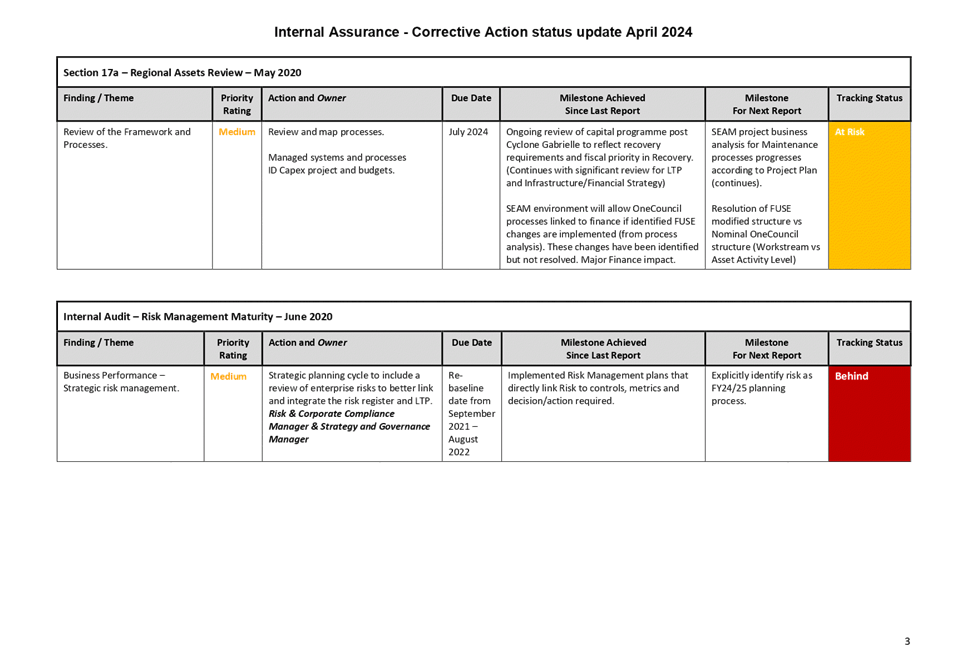
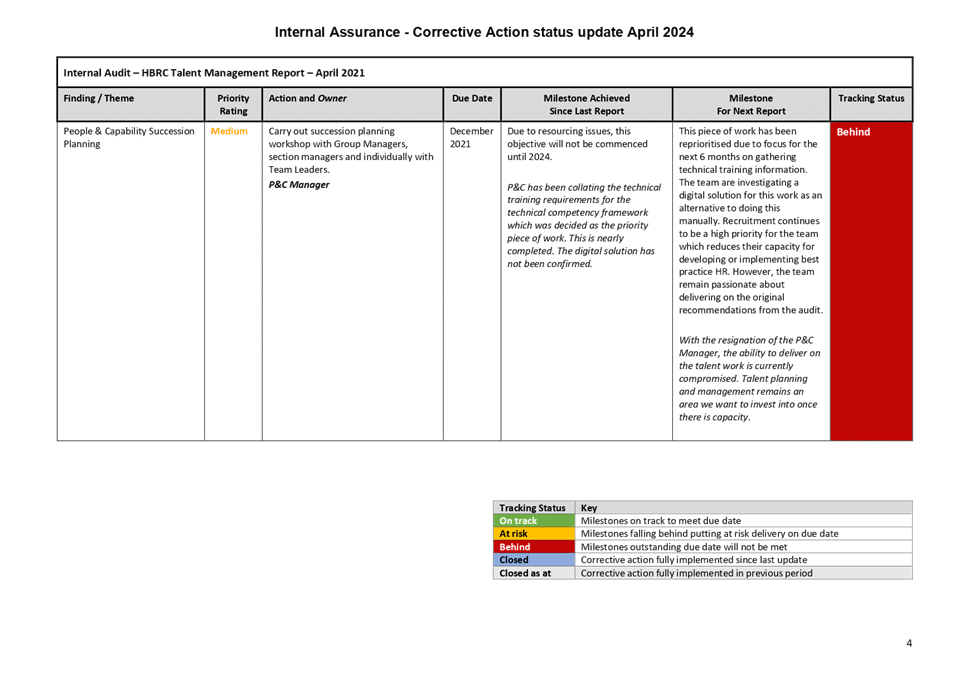
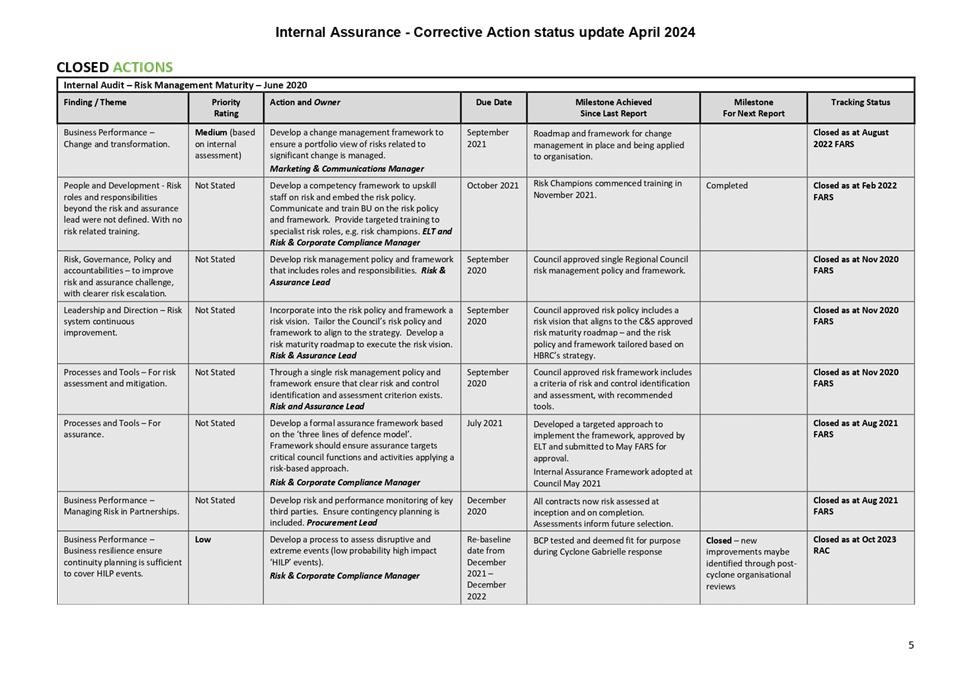
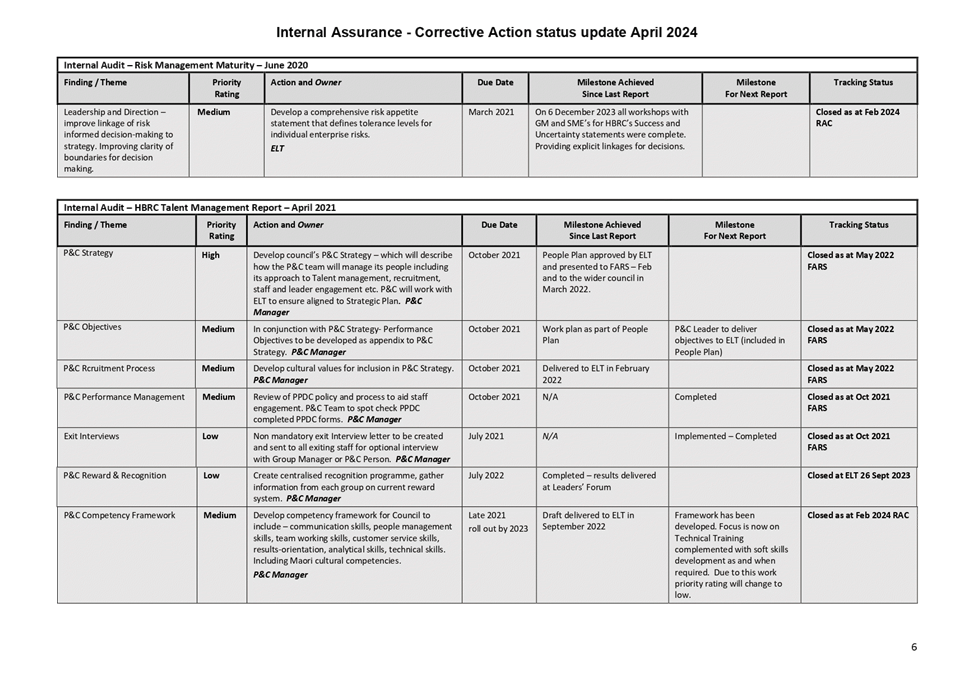
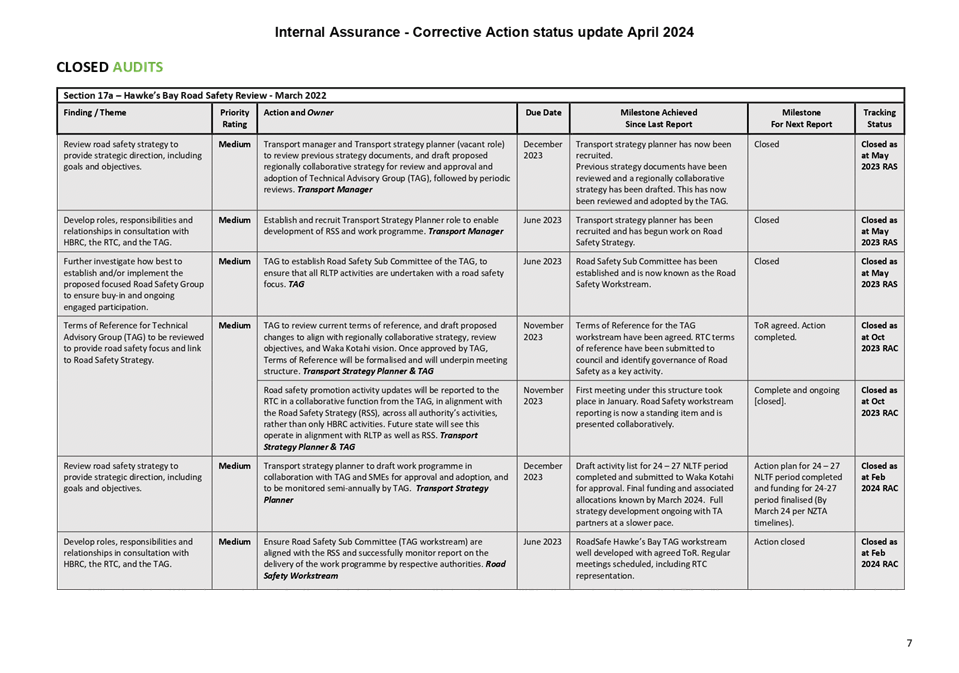
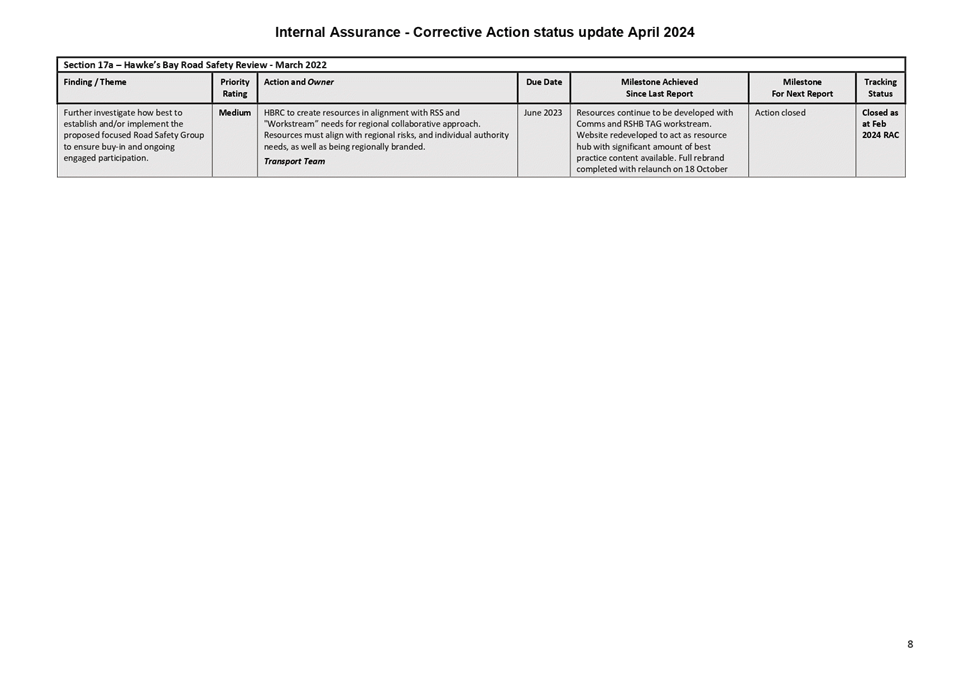
|
Internal Assurance Plan FY22-23 and 2023-24 May 2024
|
Attachment
2
|
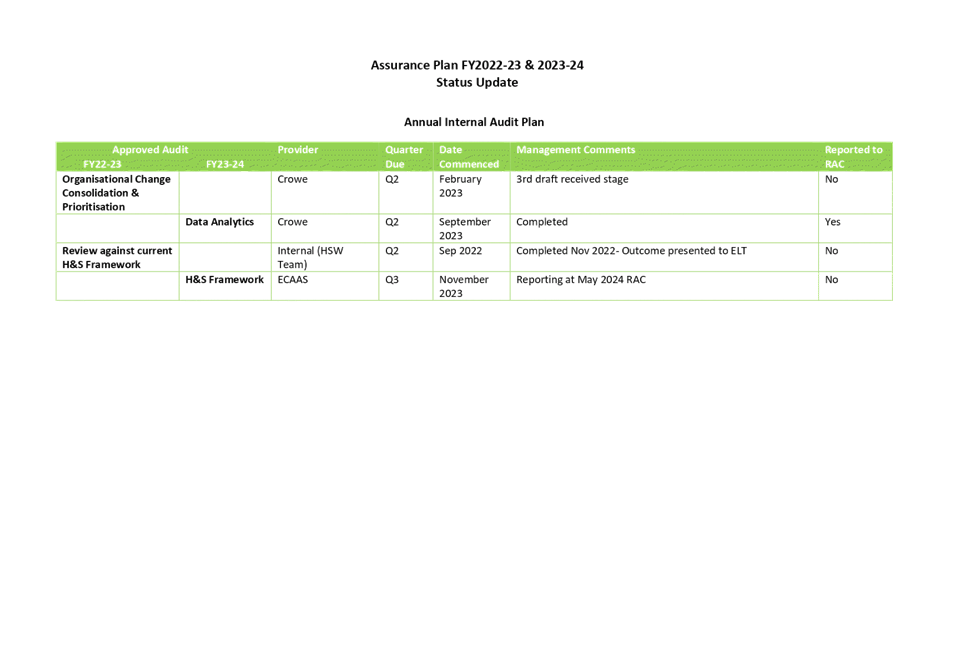
|
Assurance Universe
|
Attachment
3
|
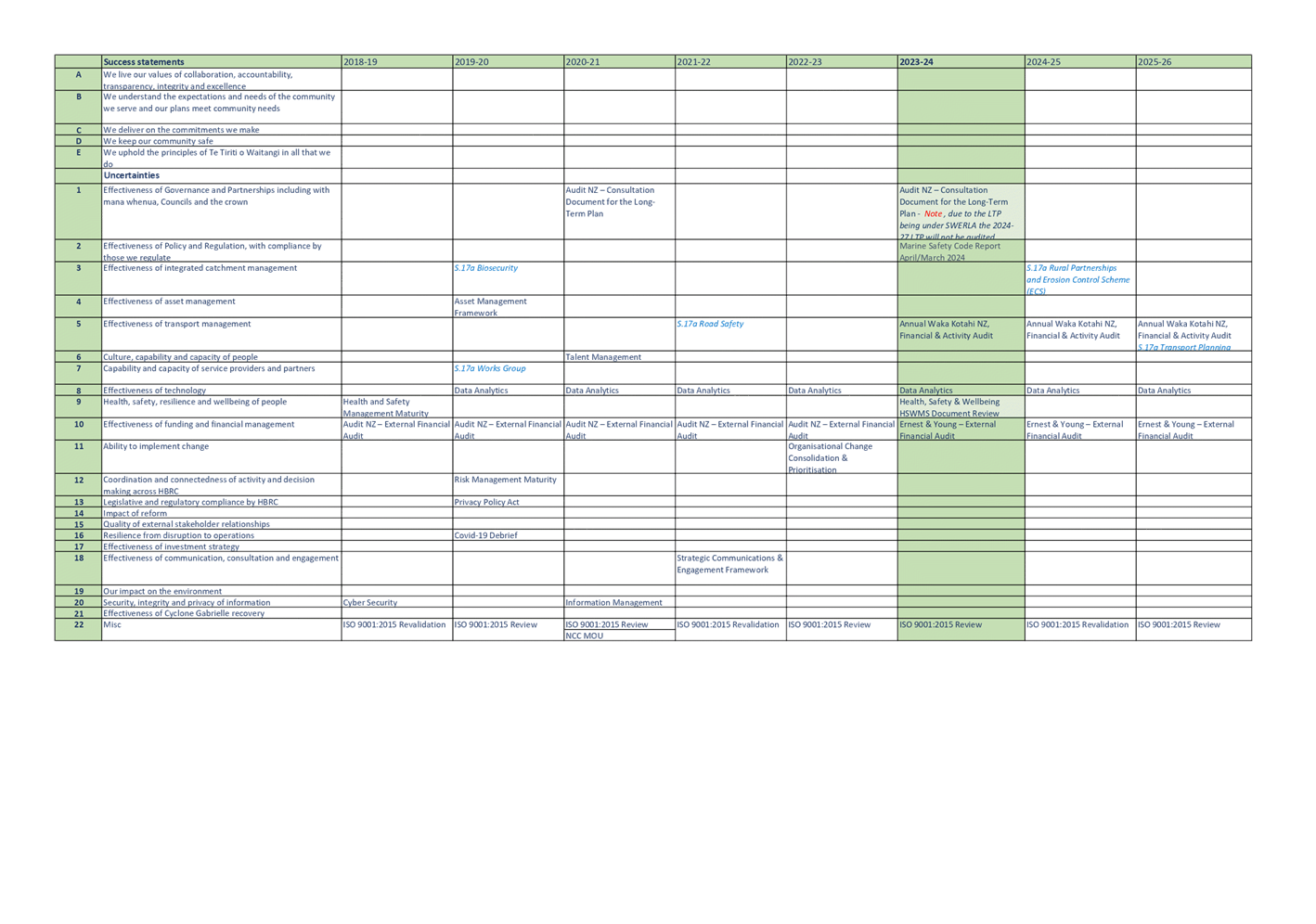
Hawke’s Bay Regional
Council
Risk
and Audit Committee
1 May 2024
Subject: Incident report - Payroll
Holidays Act compliance
That the Risk
and Audit Committee excludes the public from this section of the meeting, being
Agenda Item 8 Incident report - Payroll Holidays Act compliancewith the general
subject of the item to be considered while the public is excluded. The reasons
for passing the resolution and the specific grounds under Section 48 (1) of the
Local Government Official Information and Meetings Act 1987 for the passing of
this resolution are:
|
General
subject of the item to be considered
|
Plain
English reason for excluding the public
|
Rationale
|
Grounds under Section 48 (1) for the passing of the resolution
|
|
Incident report -
Payroll Holidays Act compliance
|
s7(2)(g) Excluding the
public is necessary to prevent disclosure of information that is legally privileged.
s7(2)(i) Excluding the
public is necessary to enable the local authority holding the information to
carry out, without prejudice or disadvantage, negotiations (including
commercial and industrial negotiations).
|
The information contained in this paper may result in
both industrial negotiations with affected staff members and commercial
negotiations with the vendor of the TechOne product. The premature disclosure
of information contained in the paper may prejudice the position of HBRC in
such negotiations.
The paper also contains information derived from legal
advice provided by in-house and external counsel. Inclusion of such material
in public-facing papers is likely to prejudice the free-flow of information
and advice in-confidence with HBRC’s legal advisors.
While there may be public interest
in this matter, as it relates to the expenditure of public monies, such
public interest is unlikely to outweigh the justifications for withholding
the information. The public interest may be satisfied by the matter being
reported on, with legally privileged material removed or redacted once the
public disclosure of these matters would not affect these industrial and
commercial positions. Moreover, relevant disclosures of these matters will be
made to the appropriate unions, satisfying the need to ensure accountability
in HBRC’s dealings with staff.
|
The Council is
specified, in the First Schedule to this Act, as a body to which the Act
applies.
|
Authored
& Approved by:
|
Susie Young
Group Manager Corporate Services
|
|
Hawke’s
Bay Regional Council
Risk
and Audit Committee
1 May 2024
Subject: Strategic risk deep dives
That the Risk
and Audit Committee excludes the public from this section of the meeting, being
Agenda Item 9 Strategic risk deep diveswith the general subject of the item to
be considered while the public is excluded. The reasons for passing the
resolution and the specific grounds under Section 48 (1) of the Local
Government Official Information and Meetings Act 1987 for the passing of this
resolution are:
|
General
subject of the item to be considered
|
Plain
English reason for excluding the public
|
Rationale
|
Grounds
under section 48(1) for the passing of the resolution
|
|
Strategic risk deep
dives
|
s7(2)(j) to prevent
disclosing information that could be used for improper gain or improper
advantage.
|
To prevent information
about Council’s critical controls being accessed.
The public interest is
protected by not allowing the information to be accessed by anyone outside
the organisation.
|
The Council is
specified, in the First Schedule to this Act, as a body to which the Act
applies.
|
Authored by:
|
Leeanne Hooper
Team Leader Governance
|
|
Approved by:
|
Susie Young
Group Manager Corporate Services
|
|
































